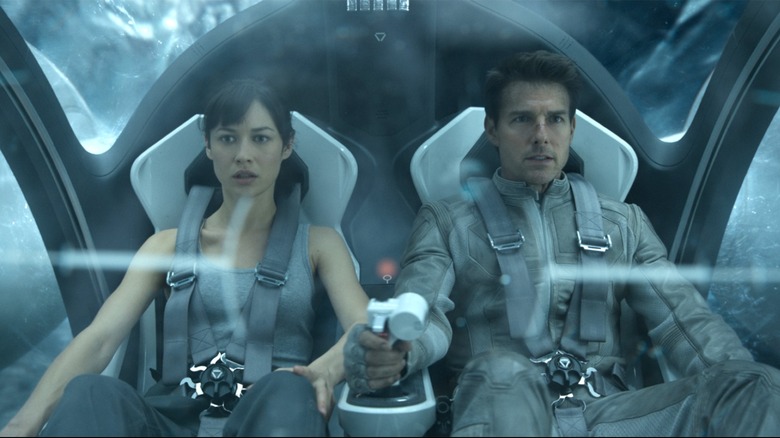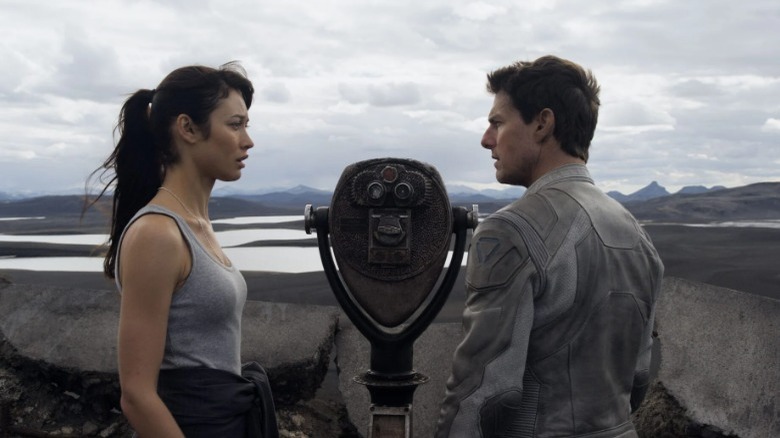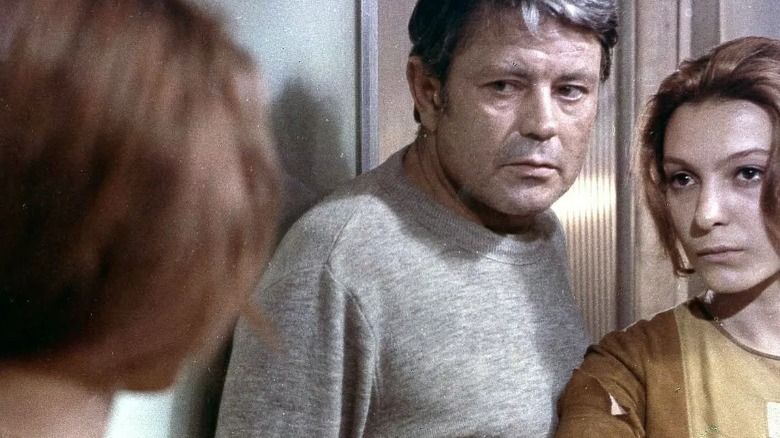How Joseph Kosinski's Oblivion Paid Homage To '60s And '70s Sci-Fi
Critical reactions to Joseph Kosinski's post-apocalyptic thriller, "Oblivion," have either been begrudgingly appreciative or outright dismissive since its release in 2013. Most perceive it as a bland, hollow tentpole movie that regurgitates telltale action-thriller beats, where Tom Cruise plays yet another morally-ambivalent character who eventually emerges as the "hero." However, the core of Kosinski's sci-fi gem lies beneath several layers of visual spectacle — somewhere in the strikingly desolate landscape, there's a lush forest opening with a cozy cabin filled with loving memorabilia. This safe space plays a seminal role for drone repair technician Jack Harper (Cruise), as it functions both as an emotional tether and a hideout until the war on Earth is over. It also elevates "Oblivion" above run-of-the-mill sci-fi entries about alien takeovers and clones, while adding layers to a thought-provoking human adventure.
Visually, "Oblivion" is as modern as it gets, utilizing a mix of real-life locations and practical designs to bring a cold, barren post-apocalyptic world to life. There is an abundance of futuristic motorcycles and bubble ships, along with minimalistic interiors that are completely devoid of personality. This is a deliberate design choice, mirroring the artificial nature of Jack and his communications partner Victoria's (Andrea Riseborough) lives, who both happen to be one of the many clones manufactured by the aliens to invade and subdue Earth.
But in terms of its core storytelling and themes, "Oblivion" takes inspiration from classic '60s and '70s sci-fi, paying tribute to the beauty and terror inherent in the entries that defined those decades. Something is amiss in Jack Harper's world, and Kosinski pays homage to some choice films to evoke these feelings of displacement and unease that run through the fabric of "Oblivion." Here's how he did it.
Inspired by a classic sci-fi gem
While Joseph Kosinski was grateful for the generous $120 million budget that allowed the story to blossom without restraints, with "Oblivion," the director was trying to evoke ideas that were bigger in scope than the budget, he said in an interview with Den of Geek. While the hefty sum allowed the crew to shoot on location in Iceland, Kosinski argued that the central idea would also have worked in less grand locales, as the narrative delivers a series of meaningful revelations that do most of the heavy lifting.
One of Kosinski's biggest inspirations was "The Twilight Zone," with most of its episodes being low-budget shorts that capitalized on strong storytelling aspects to appear larger-than-life. Another classic '70s sci-fi entry that Kosinski credited is Andrei Tarkovsky's epic "Solaris," which takes a deeply humane and meditative approach to love, loneliness, and loss. The director expressed appreciation for Tarkovsky's dazzling masterpiece while noting that "Oblivion" builds on it in wholly original ways:
"I think 'Solaris' is the epitome of '70s heavy sci-fi. There's an element of that, but I wouldn't want people to think this is 'Solaris,' because it isn't, clearly. There are elements, in that it's a film about ideas, and there is a romantic throughline that Solaris has, but it also has commercial moments — it has the action, the spectacle, the pace of a bigger movie."
The return of a loved one, which coincides with the jolting of memories, is the crux of "Solaris." Kosinski employs a similar mechanism in "Oblivion," where the wife Julia (Olga Kurylenko) acts as the catalyst for Jack Harper (Tom Cruise) to venture into the unknown in search of the truth. Yet, the parallels do not stop here.
How Solaris and other landmark sci-fi shaped Oblivion
The use of an idyllic woodland space as an emotional tether is an enduring image in Tarkovsky's vibrant sci-fi drama "Solaris," which establishes the Earth's natural abundance and beauty as a mirror to our complex human experiences. The juxtaposition between the cold space station and the woodland cabin succeeds in highlighting the follies of mankind. We have managed to alienate ourselves from true beauty to the point that love is a feeble ghost of memory — and true emotional stimulation is a lost art.
While Kosinski tackles wholly different themes in "Oblivion," he utilizes Jack's cabin in the woods as a ray of hope, and a safe haven that helps secure the future of a planet at war with an alien species. The penthouse where Jack (Tom Cruise) and Victoria (Andrea Riseborough) reside are stark reminders of their synthetic lives — they're not only clones but even their immediate environment has been tailored to suppress strong emotions. In contrast, when Jack stumbles upon his cabin in the woods, warmth creeps into his heart in ways that alter the trajectory of his life. By going rogue, and choosing to remember, this particular clone of Jack allows the impossible to happen.
Another sci-fi entry that may have inspired "Oblivion" is "Moon" — Duncan Jones' critically-acclaimed 2009 debut feature — which also tackles a similar cloning situation within the context of isolation and an innate need for human connection. Apart from this, potential literary influences include Aldous Huxley's 1932 dystopian sci-fi novel "Brave New World," where entire populaces are steered towards shallow stimulation as opposed to genuine emotions, and the novels of Philip K. Dick, which often deal with fabricated realities constructed to imprison a protagonist.
But despite those overarching inspirations, "Oblivion" retains some freshly original ideas that are worth revisiting, along with the film's staggering aesthetics and ambitious throughline.


